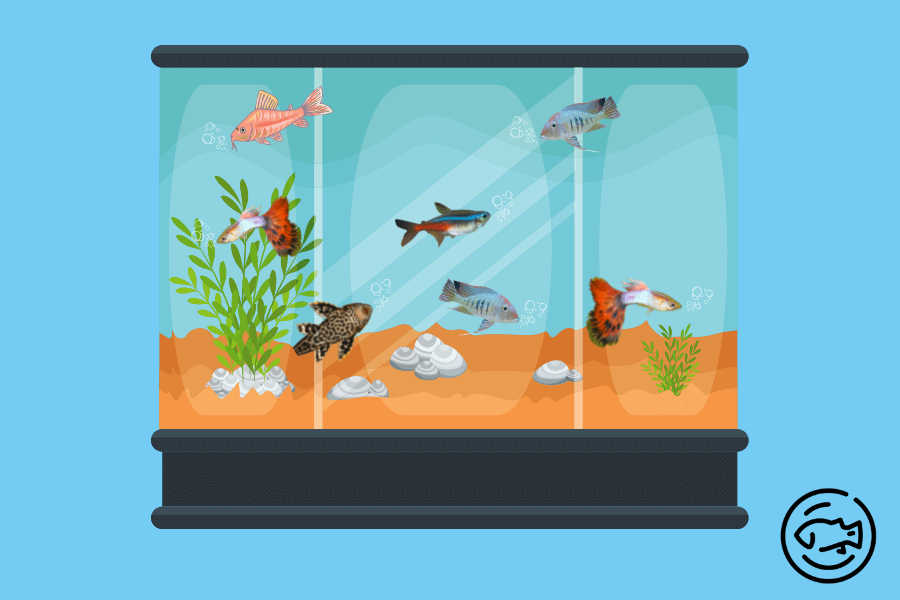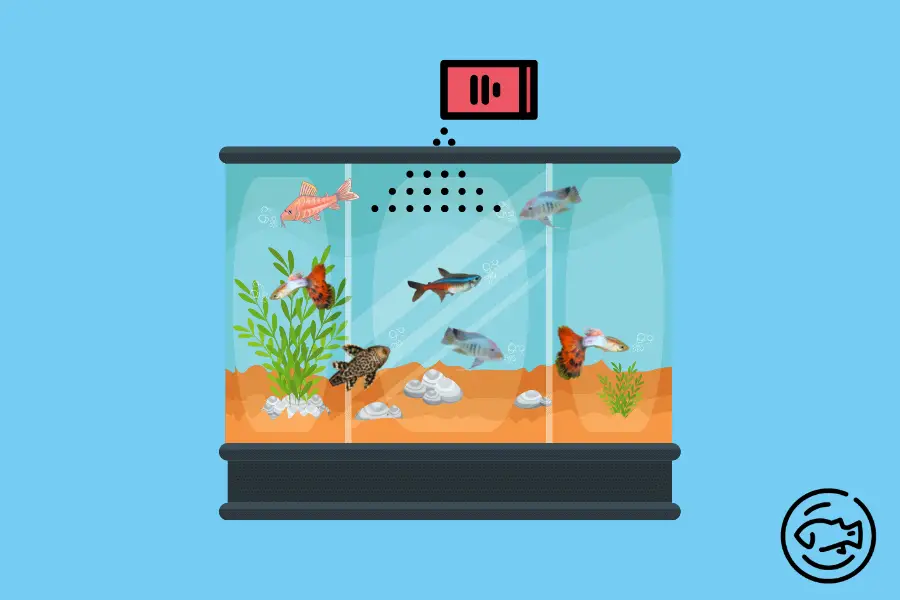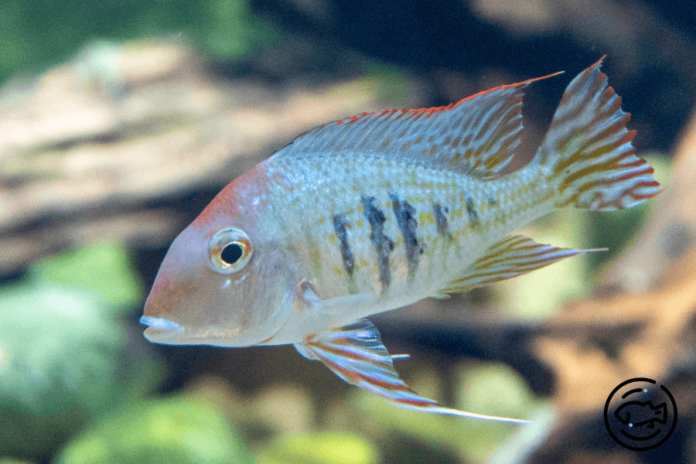Geophagus Surinamensis is a non-territorial, peaceful cichlid that comes in beautiful patterns of red, green, and blue markings.
Besides, they dig constantly and ferociously in the substrate for food, and their structure is well-designed to undertake this task with ease.
Also, the presence of a sloping, long forehead with eyes placed over the head contributes a lot.
That way, any food you give them in an aquarium should sink as much as possible because they prefer to dig their food through the substrate.
They like certain types of food, such as brine shrimp, daphnia, bloodworms, and white worms. However, animal proteins aren’t for them.
Continue reading the post to learn more about them.
Geophagus Surinamensis Overview

Otherwise known as Redstriped Eartheater, Geophagus Surinamensis is one of the best species of cichlid that you can keep.
The best feature of this species is that they habitually take significant amounts of gravel and sand into their mouth, and they do so when they are looking for food.
In addition, this species is famous for its peaceful nature and beautiful neon markings on its body. Also, they require low maintenance, making it favorable for many people to keep them as pets.
Geophagus Surinamensis is native to Amazon and Suriname Rivers in South America.
Because they are well-known bottom-dwelling species, you can find Geophagus Surinamensis in backwaters and calm ponds.
These are the most favorable places for the species because there is enough rock to provide shelter. Also, they get fine gravel, which helps them hunt for food with ease.
Geophagus Surinamensis are raised commercially worldwide, making it available in different regions.
Apart from that, they are interbred with different types of Geophagus species. The purpose is to achieve improved color differences, as they are mouthbrooders.
Geophagus Surinamensis Appearance

The juvenile fish that you buy from the fish stores come muted in color.
But after you settle them in the aquarium where they tend to grow, you can see the actual color emerge from within as the fish in well-structured tanks display a neon-like green, blue, and red pattern.
Moreover, their tails and fins come with a light blue pattern and have a flowing, long design.
However, it can cause an issue if you include other fish in the tank that attack fins.
The Redstriped Eartheater derived its name from its feeding habits and the red stripes on both sides.
It appears that the location of the eyes and slanted forehead is built differently so that they can help the Eartheater to know what’s going on while they are feeding.
Their average lifespan could be between 5 and 6 years, with seven years being the longest.
Also, they tend to grow up to 12 inches, therefore, it would be best if you had larger aquariums to keep them healthy.
Sometimes, it may take up to three years for a Geophagus Surinamensis to attain full size when it comes to a perfect growth rate.
Geophagus Surinamensis Compatibility

The only way to make sure that Geophagus Surinamensis stay in good health is to keep them away from aggressive species regardless of both big and small.
Because they are peaceful, the Redstriped Eartheater won’t bother small or big tankmates.
If you have an expansive aquarium, you can have several eartheaters.
And, they would look stunning along with adding a few bottom cleaning species, notable species, and bright-colored small fish.
The tank mates should include the following:
Corydoras
This is another variant of bottom-feeding catfish you can put in freshwater aquariums. Typically, they can grow up to four inches and are considered peaceful omnivores.
Plecos
These are beautiful bottom dwellers famous for their innate ability to keep the aquarium clean, and because they are omnivores, Redstriped Eartheater can also help in sinking food.
Although they are peaceful in nature, they are solitary as well. Therefore, it is advised to add only one in aquariums that comes in standard sizes.
Guppy
These species make good tankmates for Redstriped Eartheater as both of them are peaceful.
Also, they are almost the same size and are friendly toward each other.
Some ornamental varieties look great in aquariums as long as they don’t attack the fins.
Neon Tetra
This is another great tank mate for the Redstriped Eartheater.
You can have an ever-shimmering and moving display when you add them in a group of ten in a 20-gallon tank.
Cardinal Tetra
It is a great species that make good neighbors with different types of fish.
When you add a small group of Cardinal Tetras to an aquarium, they help to create stunning visuals as they are an excellent choice for many people.
However, add them to a group of ten.
also read: Salt And Pepper Corydoras – Facts You Need To Know!
Geophagus Surinamensis Breeding

Although not as prolific as other fish in breeding, the Redstriped Eartheater spawns in captivity.
When you have the species for breeding, you can identify the females and males by the length of their tails and fins as males would have elaborate, longer tails and fins.
Their differences are likely to show when a year has passed, and when they reach maturity, the Redstriped Eartheater breed naturally.
Some people use a blackwater conditioner to mimic the Amazon River watercolor that occurs during heavy rainfall.
Besides, this is the breeding season for many Amazon species. In addition, softening the pH level of the water is equally effective.
You can watch how they behave during this time as the male starts by making depressions on the bottom of the tank.
This is where the female is encouraged to lay eggs and fertilize them. Afterward, the female or male takes the eggs inside their mouth to keep them safe.
The eggs would mature in just three days, and although the young ones swim freely after hatching, they return to their parents when threatened by other species in the aquarium.
Keep in mind that both females and males remain aggressive during spawning.
But the parents abandon them when the little ones become too big to hide. You can feed the young Redstriped Eartheater with live and sinking foods like small brine shrimp.
Geophagus Surinamensis Diet

One of the exciting aspects of the Redstriped Eartheater is their diet.
You would find it extremely easy to feed these pets, and they appreciate a variety in what they like to eat.
Because the species is a bottom shifter, any sinking omnivore food works great for them.
Besides, mixing foods rich in protein, such as daphnia, chopped shrimp, brine shrimp, and bloodworms, is an excellent choice.
Apart from that, you can also add chopped vegetables such as squash or zucchini.
What Makes Geophagus Surinamensis Interesting?
There is no denying that the countless facts about Geophagus Surinamensis make them attractive, and here are some of them:
Bottom Dwellers
Redstriped Eartheaters love to live on the floor beds of the river, backwaters, and calm pools where they can get sufficient pebbles to hunt for food. Besides, the rock serves as a shelter for them.
Colorful
No doubt, the Red striped Eartheater is a stunning fish as they possess neon-like markings that look stunning.
However, when you buy them first or in the juvenile stage, these species would be muted in color. But once they grow and stabilize, their true colors start to emerge.
In addition, these species display patterns of blue, green, and red when they aren’t stressed and are kept in a comfortable environment.
Besides, you can find blue spot patterns on their fins and tails.
The beautiful coloration of these species makes them prized and the best addition to a home aquarium.
Peaceful Fish
Unlike other cichlids species, a Redstriped Eartheater is a sweet-tempered and peaceful fish.
And, they won’t bother other species of fish in their tank regardless of big or small. However, the male Redstriped Eartheater becomes territorial during the spawning season.
Big Fish
First, you should know that a Redstriped Eartheater takes around 2 to 3 years to attain full size.
As such, they can grow 10 to 12 inches long. Therefore, you need a larger aquarium to keep them in healthy condition.
Eartheater
As the name suggests, these species derived their name from scooping mouthfuls of sand and gravel in their mouth while searching for food.
And they eject the sifted particles with the help of their gills.
As it appears, they are built for this purpose, and moreover, the eyes and forehead help them a lot. Because they have neon-like red striped markings, the name becomes ideal.
Conclusion
Overall, the Geophagus Surinamensis is a vividly colored species and one of the best addition to home aquariums.
They are large, peaceful fish that are a must-have for South American-themed aquariums.
No wonder you would love their inquisitive manner and appreciate their natural colors.
Words can’t contain the sheer elegance that these magnificent species come with. Therefore, it is best to have them in your home.



